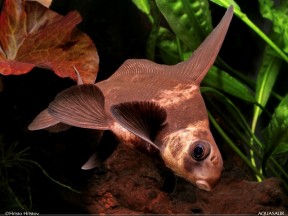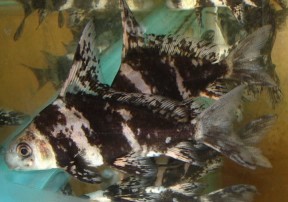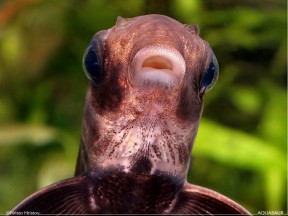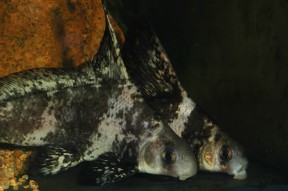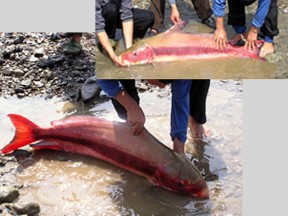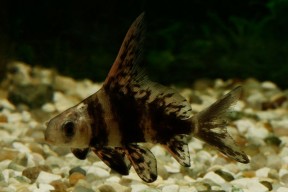Myxocyprinus asiaticus
Chinese Sailfin Sucker
Classification
Order: Cypriniformes Family: Catostomidae
Distribution
Endemic to upper and middle sections of the Yangtze River system in China including its major tributary the Min River. It’s known to be threatened across this range due to construction of dams impeding its migratory paths, pollution, overfishing and introduction of exotic species, notably carp.
It features in the China Red Data Book of Endangered Animals in which it’s currently included as a ‘second class state protected’ animal, and the population from the Min may already have disappeared.
Habitat
A pelagic species primarily occuring in main river channels and larger streams. Juveniles tend to be found in slow-flowing, shallow water with rocky substrates while larger specimens show a preference for deeper areas.
Maximum Standard Length
Can reach 800 – 900 mm and weigh up to 40kg.
Aquarium SizeTop ↑
Suitable only for public installations or the very largest private aquaria.
Maintenance
Choice of décor is not as critical as water quality and the amount of open swimming-space provided. However should you possess the means to both provide and decorate a sufficiently-sized aquarium this species a set-up designed to resemble a flowing river with a substrate of variably-sized rocks and gravel, some large water-worn boulders and perhaps a couple of driftwood branches is recommended.
Like many fishes that naturally inhabit running waters it’s intolerant to the accumulation of organic wastes and requires spotless water at all times in order to thrive. It also does best if there is a high level of dissolved oxygen and a decent level of water movement in the tank so external filters, powerheads, etc., should be employed in order to obtain the desired effect.
Water Conditions
Temperature: This species is subject to seasonal temperature fluctuations in nature and is active over the range 59 – 80°F/15 – 26.6°C, although prolonged exposure to conditions towards the upper end of this range is not recommended. Try to maintain a value between 15.5 – 21 °C for long-term care since there exist numerous reports of this fish developing fungal problems in aquaria which may be related to excessively high temperatures.
pH: 6.0 – 8.0
Hardness: 36 – 357 ppm
Diet
A benthic omnivore with insects, crustaceans, small molluscs, annelids, algae and other vegetable matter comprising the diet in nature. In the aquarium daily meals of small live and frozen foods such as bloodworm, Daphnia and Artemia should be offered alongside good quality, sinking dried products, ideally containing additional plant material such as Spirulina.
Behaviour and CompatibilityTop ↑
Not aggressive and can be maintained alongside other large, riverine species in a suitably-sized display. It apparently occurs in groups in the wild.
Sexual Dimorphism
Almost impossible to sex by external characteristics at juvenile size but adult males develop intense red colouration on the flanks when in breeding condition whereas females are plainer. The striped subadult patterning begins to break up when the fish measure 12 – 14″ in length and are already several years old.
Reproduction
Not thought to have been achieved in aquaria although the young fish available in the aquarium trade are produced and reared artificially via the use of hormones. In nature adults become sexually mature at around 6 years of age and undertake annual migrations into faster-flowing, shallow headwaters to spawn between the months of February-April, moving back into the main river channels in the autumn.
NotesTop ↑
This species is traded under various names including ‘Chinese banded shark’, ‘Chinese sucker’, ‘freshwater batfish’, ‘high-fin banded loach’, etc. It’s currently illegal to import or own privately in several countries, including the UK, but continues to be available with only the attractive juvenile form traded, and almost always without information regarding adult size of almost a metre or potential lifepan of 25 years+.
Myxocyprinus is a monotypic genus and the only Asian representative of the family Catostomidae. The majority of catostomids, commonly referred to as ‘suckers’, are native to North America where there exist almost 70 species.
They are chiefly bottom-dwelling fishes with protrusible, fleshy lips and toothless mouths although they do possess a characteristically long pharyngeal bone with toothlike projections. Some exist over relatively small ranges and are threatened by pollution, introduction of exotic species and dessication of waterways while others are important food fish.
References
- Gao, Z., Y. Li and W. Wang, 2008 - Environmental Biology of Fishes 83(3): 345-346
Threatened fishes of the world: Myxocyprinus asiaticus Bleeker 1864 (Catostomidae). - Liu, J., J. Chen, Z. Yu and L. Liu, 1995 - Asian Fisheries Science 8: 223-227
Controlled Reproduction and Broodstock Rearing of the Chinese Sucker Myxocyprinus asiaticus.
